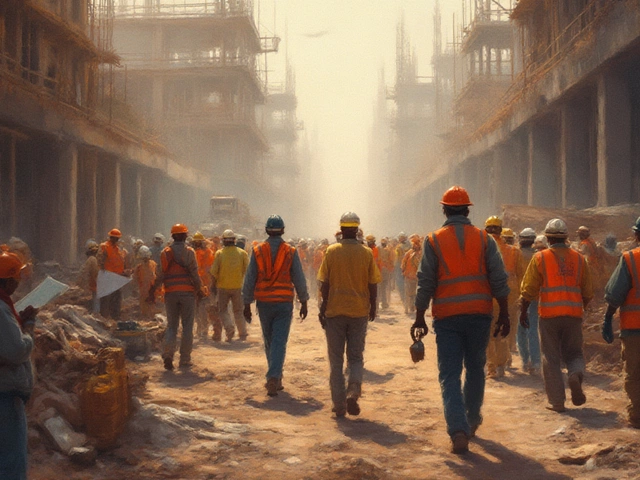Thinking about converting your loft? It's a popular choice for adding space and boosting your home's value. But before you jump in, let's talk about some of the downsides that might come with it. We all want more room, but are you ready for what it entails?
First off, let's chat money. Loft conversions aren't cheap. You might have heard they add value to your home, which they do, but remember you're looking at thousands upfront. Not something to sneeze at! Costs can escalate quickly, especially if unexpected issues crop up.
Then, there's the dreaded planning permission. Depending on where you live, you might need to jump through a few bureaucratic hoops before you can even start. Not all lofts are straightforward cases, and complications can arise if you're in a conservation area or have a tricky neighbor.
- Cost Implications
- Planning Permission Hassles
- Structural Challenges
- Impact on Living Space
- Potential Limitations and Regulations
Cost Implications
Diving into the world of loft conversions can open a Pandora's box of expenses. Let's start with the basics: the price tag. On average, converting your loft in the UK can set you back anywhere from £20,000 to £50,000. That's a lot of dosh, and it's vital to plan your budget properly.
Why so expensive? It boils down to several factors. First, there's structural changes. You might need to reinforce the floor or adjust the roof, both costly undertakings. Then there's insulation, windows, and maybe even a staircase. These aren't optional; they're essential for a liveable space.
Also, don't forget about the professional fees. Architects, structural engineers, and builders need to be paid. Not to mention any unforeseen snags that can crop up—trust us, they do!
Hidden Costs
Ever heard of hidden costs? They're the sneaky ones that catch you off guard. Think about the VAT added to construction works or the possibility of needing a party wall agreement with your neighbors. Sometimes, you'll also face increased insurance premiums due to the new space.
Potential Savings
That said, it's not all bad news. Some loft conversions might not require planning permission, and if you shop around, you could get a fair deal. Certain government incentives or loans might be available to help with eco-friendly installations too. Just remember, this won't always cut down enough to negate the hefty price.
It's crucial to weigh cost implications against the added value a conversion can bring to your property. For those living in places like Manchester, where housing prices are on the rise, a well-done loft could be a smart investment. Just make sure you're not betting the farm on it.
Planning Permission Hassles
So, you're set on that loft conversion, but what's the deal with planning permission? It's one of those things folks often overlook, yet it can throw a wrench in your renovation plans in the UK. Before you begin, figuring out what permissions you need is key.
Here's the thing: Not all loft conversions require planning permission. The UK has something called 'Permitted Development Rights.' If your project falls within certain limits, you might not need full permission. Sounds easy, right? Not always.
When You Do Need Planning Permission
If you're making big changes, like altering the roof significantly or adding a large dormer, you'll probably need permission. Also, if you live in a conservation area or a listed building, the rules get stricter.
- Height Matters: There's a height limit for additions. If your extension exceeds it, you'll need to get approval.
- Neighbours: Sometimes it's about how the changes affect your neighbors. Blocking their light? Expect some pushback, and possibly, the need for permission.
- More Rules: Conservation areas and listed buildings can have special requirements, so always double-check if your postcode falls in one of these zones.
Getting Through the Process
Once you know you need it, the planning process can be long and tedious. It involves submitting detailed plans to your local council and waiting for a decision. How long? It could take up to eight weeks or more!
Oh, and there's a fee involved too. Prices vary by council, but factor this in your budget. Remember, getting denied can mean rework without a refund.
Don't forget to have a chat with your neighbours before starting. Building relationships now can prevent issues later. No one wants a disgruntled neighbour when you're trying to improve your home!
| Typical Planning Permission Process Timeline | Average Time (Weeks) |
|---|---|
| Initial Submission | 1-2 |
| Review by Council | 3-4 |
| Potential Revisions | 2-3 |
| Final Decision | 1-2 |
In short, dealing with planning permission can feel like a slog, but it's crucial to ensure your home renovation stays on the right side of the law. Plus, having everything above board means fewer headaches down the line and certainly more peace when you enjoy your new space.

Structural Challenges
When considering a loft conversion, one of the first things to examine is the structure of your house. It's not just about throwing in a few walls and calling it a day. You have to ensure the existing structure can handle the extra load. This can be a major concern, especially in older homes.
An often overlooked issue is the condition of the roof. Most roofs aren't designed to bear the weight of a fully converted loft space. You might need to reinforce or even replace parts of it, which can significantly bump up the costs. According to John Thompson, a well-known architect in Manchester, "Many homeowners forget to account for roof reinforcement in their initial budgets, leading to unpleasant surprises later."
Floor Support
Don't forget about the floors either! Floor joists in lofts weren't originally meant to support bedrooms or offices. They may require upgrades to prevent sagging or instability, which becomes an essential part of the conversion process.
Access and Headroom
Another thing to keep in mind is access. Installing a stairway that meets building regulations can be trickier than it sounds. Lack of headroom is another nuisance. Building regulations usually require at least 2.2 meters of headroom over the stairs for compliance, which not all lofts have.
As daunting as these challenges may seem, being aware of them can lead to better planning and fewer headaches down the line. Consulting with a structural engineer early in the process is a good move. While home renovation inevitably comes with hurdles, tackling them head-on makes the reward worth the effort.
Impact on Living Space
When you decide on a loft conversion, it's not just about gaining more room; it also means considering how the space impacts your home's overall flow and feel. Sudden bursts of extra square footage can truly change the dynamic of your living area, sometimes in unexpected ways.
Let's start with the stairs. Installing a staircase to access your new loft can eat into the existing space below. You'll need to figure out where this will go and if it disrupts your home's current layout. It's more than just finding a corner to shove a staircase in; you need to make it practical and safe.
Ceiling Height Woes
Next, think about headspace. Not all loft areas have enough height, which can make things feel cramped. If you've got less than 2.2 meters, it might not be a comfortable living area. Some folks opt for dormer windows or even raising the roof, which raises the project cost significantly.
Natural Light Considerations
Then there's light. Most lofts aren't bright and airy by default. Adding windows or skylights can help but, again, this adds to the cost and complexity. Plus, if your property faces in an odd direction, you might not get the natural light you hoped for, which can lead to a gloomy atmosphere.
Noise and Privacy
Finally, let's talk noise and privacy. Depending on how your loft is situated, noise from below can be a problem. And if it's going to be a bedroom, you have to ponder privacy levels. Proper insulation and thoughtful layout planning are key here.
So, while a loft conversion promises extra living space, the reality is it needs careful planning to ensure it adds the right kind of value. Balancing these factors with enthusiasm and a bit of realism ensures that the new area feels like a truly integrated part of your home.

Potential Limitations and Regulations
When considering a loft conversion, you've got to think about the potential limitations and the web of regulations that might stand in your way. Right from the get-go, it's not just about climbing up there with a hammer.
First off, not all homes are the best candidates for extensions. Your existing roofing style and structure can be a major hurdle. For instance, if your home has a trussed roof, converting it might be trickier due to structural intricacies.
Now, talking about regulations, you'll want to check if your project needs planning permission. Many folks get caught off guard here. Simple-looking projects can get complicated, requiring various permissions. As of 2023, in some parts of the UK, including areas around Manchester, certain types of loft conversions fall under 'permitted development rights'. But it's not a free pass. If your home is in a designated area like a conservation zone, you'll likely face stricter controls.
Building Regulations Approval
Beyond planning permissions, you'll need to comply with building regulations. These cover structural safety, fire safety, insulation, and more. Basically, they ensure your new room is a safe place to live. Did you know? Studies show that failing to meet these could lead to fines or even the undoing of your hard work.
- Fire Safety: Making sure you have a proper route of escape in an emergency is a must.
- Insulation: Ensuring adequate thermal insulation keeps energy bills in check.
- Stability: Reinforcing floor strength to carry additional weight is crucial.
There are also particular rules for stairways, windows, and overall design. Missing these might mean redoing work, so getting it right the first time is crucial.
Party Wall Agreements
If you're sharing walls with neighbors, like in terraced or semi-detached homes, a Party Wall Agreement could be necessary. This is basically a friendly contract ensuring that any work doesn't damage shared structures. A good relationship with your neighbor and a proper agreement can save you from headaches down the road.
Feeling overwhelmed? You're not alone! Many folks hire professionals to navigate these waters. But being aware of these factors empowers you to make informed decisions, saving time and money. Good luck with your loft conversion journey!






